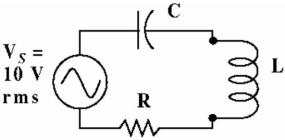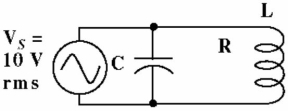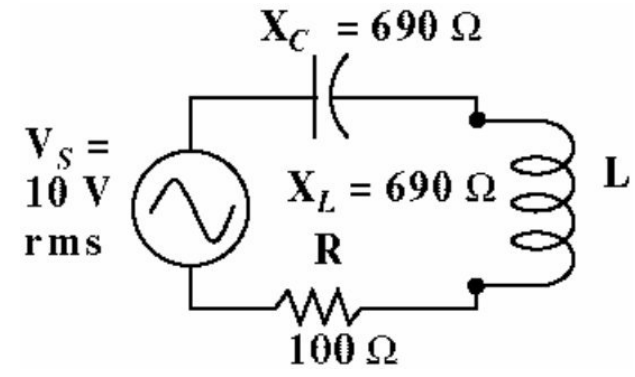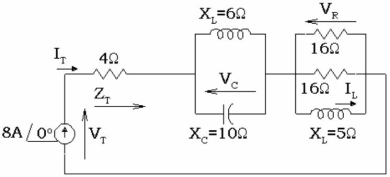Deck 17: Rlc Circuits and Resonance
Question
Question
Question
Question
Question
Question
Question
Question
Question
Question
Question
Question
Question
Question
Question
Question
Question
Question
Question
Question
Question
Question
Question
Question
Question
Question
Question
Question
Question
Question
Question
Question
Question
Question
Question
Question
Question
Question
Question
Question
Question
Question
Question
Question
Question
Question
Question
Question
Question
Question

Unlock Deck
Sign up to unlock the cards in this deck!
Unlock Deck
Unlock Deck
1/50
Play
Full screen (f)
Deck 17: Rlc Circuits and Resonance
1
 Figure 17-1
Figure 17-1If the series circuit in Figure 17-1 is resonant, the inductive and capacitive reactance must be equal.
True
2

If the parallel circuit in Figure is resonant, the circuit is purely resistive and the phase shift is zero degrees.
True
3
Resonant frequency of a circuit occurs when the inductive reactance is equal to the capacitive reactance.
True
4

Given the circuit in Figure, the circuit current is:
A) 1 A
B) 198 µA
C) 0.87 mA
D) 100 mA

Unlock Deck
Unlock for access to all 50 flashcards in this deck.
Unlock Deck
k this deck
5

If the parallel circuit in Figure is resonant, the impedance, as seen by the generator will be very high.

Unlock Deck
Unlock for access to all 50 flashcards in this deck.
Unlock Deck
k this deck
6
In a series RLC circuit, above resonance the circuit is more capacitive than it is inductive.

Unlock Deck
Unlock for access to all 50 flashcards in this deck.
Unlock Deck
k this deck
7
A parallel resonant circuit has a low impedance at the resonant frequency.

Unlock Deck
Unlock for access to all 50 flashcards in this deck.
Unlock Deck
k this deck
8
In a series resonant circuit, current is maximum and impedance is minimum at resonance.

Unlock Deck
Unlock for access to all 50 flashcards in this deck.
Unlock Deck
k this deck
9
 Figure 17-1
Figure 17-1If the series circuit in Figure 17-1 is resonant, the impedance, as seen by the generator will be very high.

Unlock Deck
Unlock for access to all 50 flashcards in this deck.
Unlock Deck
k this deck
10
A parallel tuned circuit can be used to couple energy from one circuit to another.

Unlock Deck
Unlock for access to all 50 flashcards in this deck.
Unlock Deck
k this deck
11

Given the circuit in Figure , the circuit impedance is:
A) 690 Ω
B) 100 Ω
C) 318 Ω
D) 345 Ω

Unlock Deck
Unlock for access to all 50 flashcards in this deck.
Unlock Deck
k this deck
12

If the parallel circuit in Figure is NOT resonant, the impedance will be lower than it is at the resonant frequency.

Unlock Deck
Unlock for access to all 50 flashcards in this deck.
Unlock Deck
k this deck
13

If the parallel circuit in Figure is resonant, increasing the Q will produce a wider bandwidth.

Unlock Deck
Unlock for access to all 50 flashcards in this deck.
Unlock Deck
k this deck
14

Given the circuit in Figure , the circuit impedance is:
A) 5.88 Ω
B) 6.4 Ω
C) 14.46 Ω
D) 8.1 Ω

Unlock Deck
Unlock for access to all 50 flashcards in this deck.
Unlock Deck
k this deck
15
A series resonant circuit has a low impedance at the resonant frequency.

Unlock Deck
Unlock for access to all 50 flashcards in this deck.
Unlock Deck
k this deck
16
 Figure 17-1
Figure 17-1If the series circuit in Figure 17-1 is resonant, the circuit is purely resistive and the phase shift is zero degrees.

Unlock Deck
Unlock for access to all 50 flashcards in this deck.
Unlock Deck
k this deck
17

If the parallel circuit in Figure is resonant, the inductive and capacitive reactance must be equal.

Unlock Deck
Unlock for access to all 50 flashcards in this deck.
Unlock Deck
k this deck
18
By increasing the resistance of a coil you can increase the Q of the coil at resonance.

Unlock Deck
Unlock for access to all 50 flashcards in this deck.
Unlock Deck
k this deck
19
 Figure 17-1
Figure 17-1If the series circuit in Figure 17-1 is NOT resonant, the impedance will be lower than it is at the resonant frequency.

Unlock Deck
Unlock for access to all 50 flashcards in this deck.
Unlock Deck
k this deck
20
 Figure 17-1
Figure 17-1If the series circuit in Figure 17-1 is resonant, increasing the Q will produce a wider bandwidth.

Unlock Deck
Unlock for access to all 50 flashcards in this deck.
Unlock Deck
k this deck
21

Given the circuit in Figure 17-5, the circuit phase angle is:
A) 90°
B) 34.5°
C) -5.4°
D) -1.3°

Unlock Deck
Unlock for access to all 50 flashcards in this deck.
Unlock Deck
k this deck
22

The current through the capacitor in Figure is:
A) 159.7 mA
B) 434 mA
C) 279.65 mA
D) 4.3 A

Unlock Deck
Unlock for access to all 50 flashcards in this deck.
Unlock Deck
k this deck
23

The Circuit impedance in Figure is:
A) 70.5 Ω
B) 7.55 Ω
C) 265 Ω
D) 33 Ω

Unlock Deck
Unlock for access to all 50 flashcards in this deck.
Unlock Deck
k this deck
24
At resonance the power factor is:
A) negative
B) 1
C) M5
D) zero
A) negative
B) 1
C) M5
D) zero

Unlock Deck
Unlock for access to all 50 flashcards in this deck.
Unlock Deck
k this deck
25

The inductive reactance in Figure is:
A) 2.7 kΩ
B) 750 Ω
C) 2.6 Ω
D) 7.5 Ω

Unlock Deck
Unlock for access to all 50 flashcards in this deck.
Unlock Deck
k this deck
26
At frequencies well above and below the resonant frequency, the series RLC circuit looks above resonance, and the parallel RLC circuit looks below resonance.
A) like an open, like a short
B) like a short, like an open
C) inductive, inductive
D) inductive, capacitive
A) like an open, like a short
B) like a short, like an open
C) inductive, inductive
D) inductive, capacitive

Unlock Deck
Unlock for access to all 50 flashcards in this deck.
Unlock Deck
k this deck
27

Given the circuit in Figure 17-4, is the circuit mostly inductive or capacitive?
A) capacitive
B) inductive

Unlock Deck
Unlock for access to all 50 flashcards in this deck.
Unlock Deck
k this deck
28

The capacitive reactance in Figure is:
A) 159.7 Ω
B) 26.53 Ω
C) 265.3 Ω
D) 2.7 kΩ

Unlock Deck
Unlock for access to all 50 flashcards in this deck.
Unlock Deck
k this deck
29

The True power in Figure is:
A) 200.7 W
B) 7.5 W
C) 43.29 W
D) 401 W

Unlock Deck
Unlock for access to all 50 flashcards in this deck.
Unlock Deck
k this deck
30
In a series LC circuit, L = 100 µH, C = 0.047 µF, and f = 150 kHz. The value of ZT is:
A) 72
90°
B) 36
45°
C) -72
-90°
D) 72
-90°
A) 72
90°
B) 36
45°
C) -72
-90°
D) 72
-90°

Unlock Deck
Unlock for access to all 50 flashcards in this deck.
Unlock Deck
k this deck
31

The phase shift between the source voltage VS and total circuit current in Figure is:
A) -46.45°
B) 23.4°
C) -23.4°
D) -76.8°

Unlock Deck
Unlock for access to all 50 flashcards in this deck.
Unlock Deck
k this deck
32
Is the circuit in Figure 17-5, at or very close to resonance?
A) Yes
B) No
A) Yes
B) No

Unlock Deck
Unlock for access to all 50 flashcards in this deck.
Unlock Deck
k this deck
33
Apparent power in an RLC circuit is equal to total voltage times total current when:
A) the circuit is not at resonance
B) the circuit is at resonance.
C) it is a series or parallel circuit
D) all of the above
A) the circuit is not at resonance
B) the circuit is at resonance.
C) it is a series or parallel circuit
D) all of the above

Unlock Deck
Unlock for access to all 50 flashcards in this deck.
Unlock Deck
k this deck
34

The Total circuit current in Figure is:
A) 4.3 A
B) 14.87 A
C) 15.2 A
D) 3.5 A

Unlock Deck
Unlock for access to all 50 flashcards in this deck.
Unlock Deck
k this deck
35

The current through the resistor in Figure is:
A) 459.65 mA
B) 15.9 A
C) 350 mA
D) 3.48 A

Unlock Deck
Unlock for access to all 50 flashcards in this deck.
Unlock Deck
k this deck
36

Given the circuit in Figure 17-5, the circuit current is:
A) 7.64 mA
B) 36.9 mA
C) 0.1 A
D) 3.03 mA

Unlock Deck
Unlock for access to all 50 flashcards in this deck.
Unlock Deck
k this deck
37
The lower and upper end of the band width of a series RLC circuit is where the current has fallen to of the maximum.
A) 70.7%
B) 63.6%
C) 29.3%
D) 50%
A) 70.7%
B) 63.6%
C) 29.3%
D) 50%

Unlock Deck
Unlock for access to all 50 flashcards in this deck.
Unlock Deck
k this deck
38

The current through the inductor in Figure is:
A) 27.9 A
B) 15.3 A
C) 153 mA
D) 1.5 A

Unlock Deck
Unlock for access to all 50 flashcards in this deck.
Unlock Deck
k this deck
39

Given the circuit in Figure , the circuit impedance is:
A) 3.3 kΩ
B) 6.94 kΩ
C) 27.1 kΩ
D) 7.07 kΩ

Unlock Deck
Unlock for access to all 50 flashcards in this deck.
Unlock Deck
k this deck
40

Is the circuit in Figure 17-7 at or near resonance?
A) No
B) Yes

Unlock Deck
Unlock for access to all 50 flashcards in this deck.
Unlock Deck
k this deck
41

In Figure 17-8, calculate VR.
A) 33.9 V 2-58°
B) 95.0 V 2-39°
C) 33.9 V 258°
D) 95.0 V 239°

Unlock Deck
Unlock for access to all 50 flashcards in this deck.
Unlock Deck
k this deck
42

-calculate ZT.
A) 58
-39°
B) 58
39°
C) 19.6
71.4°
D) 19.6
-71.4°

Unlock Deck
Unlock for access to all 50 flashcards in this deck.
Unlock Deck
k this deck
43
Half-power frequencies
A) determine the pass band.
B) determine bandwidth.
C) determine selectivity.
D) all of the above
E) none of the above
A) determine the pass band.
B) determine bandwidth.
C) determine selectivity.
D) all of the above
E) none of the above

Unlock Deck
Unlock for access to all 50 flashcards in this deck.
Unlock Deck
k this deck
44
In a series LC circuit, VL = 8.3 V and VC = 10.6 V. VS = .
A) -2.3 V 2-90°
B) 8.3 V 2-90°
C) -2.3 V 290°
D) 2.3 V 2-90°
A) -2.3 V 2-90°
B) 8.3 V 2-90°
C) -2.3 V 290°
D) 2.3 V 2-90°

Unlock Deck
Unlock for access to all 50 flashcards in this deck.
Unlock Deck
k this deck
45
The center frequency of a band-pass filter is always equal to the .
A) geometric mean average of the cutoff frequencies
B) 3-dB frequency
C) bandwidth divided by Q
D) bandwidth
A) geometric mean average of the cutoff frequencies
B) 3-dB frequency
C) bandwidth divided by Q
D) bandwidth

Unlock Deck
Unlock for access to all 50 flashcards in this deck.
Unlock Deck
k this deck
46

In Figure 17-8, calculate IT.
A) 157 A 2-71.4°
B) 464 A 2-39°
C) 157 A 271.4°
D) 464 A 239°

Unlock Deck
Unlock for access to all 50 flashcards in this deck.
Unlock Deck
k this deck
47

In Figure 17-8, calculate VC.
A) 40 V 260°
B) 40 V 2-60°
C) 120 V 2-90°
D) 120 V 290°

Unlock Deck
Unlock for access to all 50 flashcards in this deck.
Unlock Deck
k this deck
48
In a series RLC circuit, R = 1.1 kΩ, XL = 1.6 kΩ, and XC = 2.9 kΩ. ZT = .
A) 4.6 k
-50°
B) 4.6 k
50°
C) 1.7 k
50°
D) 1.7 k
-50°
A) 4.6 k
-50°
B) 4.6 k
50°
C) 1.7 k
50°
D) 1.7 k
-50°

Unlock Deck
Unlock for access to all 50 flashcards in this deck.
Unlock Deck
k this deck
49
If the bandwidth of a filter increases, .
A) ripples appear in the stopband
B) the roll-off rate increases
C) Q decreases
D) the center frequency decreases
A) ripples appear in the stopband
B) the roll-off rate increases
C) Q decreases
D) the center frequency decreases

Unlock Deck
Unlock for access to all 50 flashcards in this deck.
Unlock Deck
k this deck
50

calculate VL across the 5Ω inductive reactance
A) 95.0 V
 39°
39°B) 33.9 V 11ec81bf_ec6d_acdc_bc38_29a3f7414e20_TB34225555_11 -58°
C) 95.0 V 11ec81bf_ec6d_acdc_bc38_29a3f7414e20_TB34225555_11 -39°
D) 33.9 V 11ec81bf_ec6d_acdc_bc38_29a3f7414e20_TB34225555_11 58°

Unlock Deck
Unlock for access to all 50 flashcards in this deck.
Unlock Deck
k this deck



